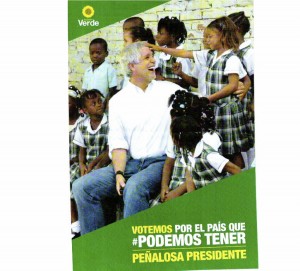https://www.youtube.com/watch?v=4Y0j8dt92Vs
Of course not. But it seems that the presidential campaign of Enrique Peñalosa seems to think so. Watch the ad above.
Here’s a translation:
“A bicycle is something you learn and never forget. It’s about maintaining momentum without losing balance. It’s about owning your destiny, believing in your dreams, and helping others achieve their own. It’s about your own force. It’s more than a bicycle. It’s our determination to get out ahead. The bicycle unites us. There are only a few days left to elect our future. This Sunday, 18th of May, let’s pedal for Colombia.” This last bit is an invitation to join Peñalosa on what his party website calls a “characteristic ciclopaseo” in Bogotá to close the campaign.
The first round of presidential elections are this weekend, and Peñalosa’s campaign seems doomed to not survive. These elections have been especially contentious, with some pretty major mudslinging and scandalous dirty tricks between the top two candidates that commentators say they haven’t seen in a while. Those candidates, the president Juan Manuel Santos and his main rival the ultra-conservative Oscar Iván Zuluaga, have accused each other of (contra Zuluaga) hiring a computer hacker to spy on the emails of the peace negotiators in Havana and even the president’s email and then getting caught lying about it and (contra President Santos) of accepting money from drug barons.
As the acrimony has deepened, many thought Peñalosa’s chance to rise above it all and gain the lead had come, because of his consistently positive message and his distance from the traditional political machinations that generate all the corruption and political stagnation associated with the top two candidates and their parties. But his response has been surprisingly subdued and, independent of that, some key figures on the left, including the mayor of Bogotá, deserted him and aligned themselves with the President to avoid an ultra-conservative take over. No doubt that took some wind out of Peñalosa’s sails. In these last days a key message coming out of his campaign seems to have been to unleash the bicycle theme, ramping up the bicycle discourse and projecting the bicycle as a metaphor for what can unite the country.
This country, as one history book calls it “a nation in spite of itself,” has been profoundly divided for decades. But even as powerful a symbol of Colombianness as the bicycle is, its resonance doesn’t seem to translate very effectively to the political arena. As one bemused colleague of mine at the university reflected, “I haven’t ridden a bike in years! You have to be crazy to ride a bike in this city! People want cars.” It’s not that this individual is anti-Peñalosa or even anti-bike, but when people’s notions of bicycles are filtered in such a way, one cannot but help see the limits of Peñalosa’s gambit.
Indeed, even though levels of car ownership are among the lowest in Latin America, development economists and national economic planners are expecting the number of cars in this country to grow as incomes have risen. Currently in Colombia, for example, there are about 8 cars per 100 people, with a bit less than that in Bogotá. But the visions of economic planners is that Bogotá should aspire to become more like Santiago, Chile (25 cars per 100 people) or Lima, Peru (22 cars per 100 people). For Bogotá, a city already mired in profound mobility problems, this is a horrific vision since it would lead to a collapse in the urban transportation system, of complete immobility. One government economic planner I spoke with recognizes the problem, but seems resigned. “I know, it’s terrible. But it’s a sign of our economic growth.” It makes you wonder, if Peñalosa projected a rosy future of car-driving Colombians, would he be on top?
